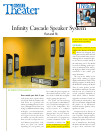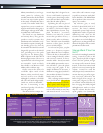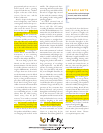
proportional and not excessive. I
found myself with a growing
respect for both the star—whether
despite or because of his frosty
reserve, I’m not sure—and the
delicacy of the mix.
Munich, despite its heightened
moral complexity, came with an
extravagantly ultraviolent proces-
sion of explosions and gunshots
that tested the mettle of every
driver in the system. Right from
the opening frames, the Cascades
grabbed me with the soundtrack’s
mourning female vocal and string
orchestra, and they never let go.
The sub did well with minor
details, like the low ambient hum
of trains and buses, but also stood
up to the stiffer demands of the
hotel explosion—not a single det-
onation but an extended ballet of
destruction. It was convincing
enough to be unnerving, as a
movie on this subject should be.
The next thing I played after
Munich was the stereo SACD of
Bernard Herrmann: The Film Scores by
Esa-Pekka Salonen and the Los
Angeles Philharmonic. It includes
excerpts from six of the sound-
tracks Herrmann wrote for Alfred
Hitchcock, including a suite from
Psycho, a string-orchestra master-
piece that could outgun any heavy
metal band. Going from angst-
ridden terrorism and assassination
to a soundtrack that evokes some-
one being stabbed in the shower
was a soft landing of sorts—I could
almost hear Sir Alfred saying,
“Don’t worry, dear. It’s just a
moooovie.” Even with no surround
mix and just two speakers operat-
ing, the Cascades could throw
out a convincing soundstage that
dominated every seat in the room.
I could sit directly in front of the
left speaker and still hear continu-
ous imaging with no hole in the
middle. The voluptuously disso-
nant string-and-brass textures that
open the Vertigo suite billowed like
the sails of a clipper ship caressed
by the wind, the ostinatos evoking
the opening credits’ unforgettable
spiraling graphics.
An SACD surround mix of
Beethoven’s ninth symphony didn’t
fare as well. The 1977 analog
recording by Herbert von Karajan
and the Berlin Philharmonic was
mastered in 96/24 PCM before its
transfer to SACD. In my opinion,
the string sound is less refined than
that of a native or straight-from-
analog SACD, and the Cascades
didn’t hesitate to tell me how they
felt about that. Despite the skillful
performance, what should have
been a rich assortment of vocal and
instrumental tone color came out
monochromatic and lacking in spa-
tiality. I wouldn’t call these speak-
ers “ruthlessly revealing”—code
language for products that make a
large percentage of recordings
sound unpleasant—nor did they
add any sweetening of their own.
They were just finicky and truth-
ful, as an audiophile should be. In
this case I think they were actually
disappointed in the recording.
They cheered up when I got to
Sinatra at the Sands on DVD-Audio.
I could hear the effect of cigarettes
on Sinatra’s lungs and throat, the
precision of the consonants that
flowed delicately and precisely
through his teeth and lips, the way
all of this interacted with the
microphone and the acoustics of the
club, and individual voices in the
audience laughing at his awful
jokes. The focus couldn’t have been
tighter or the spotlight brighter.
Of the dozens of CDs I played,
the most memorable was 10,000
Clowns on a Rainy Day by Jan
Akkerman. The former guitarist of
Focus has lived down his former
band’s 1971 yodeling hit “Hocus
Pocus” to pursue a lengthy solo
career. His trusty Les Paul is the
focal (sorry) point of this mainly
instrumental live double-CD set.
The Cascades brought it to the
front of the mix, slightly in front
of the speakers in Dolby Pro Logic
II, while the band lingered slightly
behind. It was like looking at
a richly colored object against
a black-and-white background.
Akkerman’s supple intonation was
a living, breathing, dancing sonic
creature. Although visual responses
to sounds are routine for me, in
this case, I also tasted the guitar: It
tasted like dark chocolate.
Like waves breaking on a beach,
reviewing these speakers was a long
and steady succession of favorable
impressions. They looked great.
They were easy to set up. There
was no screeching, no distancing,
and no sweetening. The equalized
subwoofer nimbly sidestepped my
room’s bass hump. Broad off-axis
response from the flat woofers and
waveguide-enhanced tweeters lib-
erated me from the sweet spot. The
Cascades gave me an unparalleled
freedom to listen from any spot in
the room and with any kind of
material, and, for that, I am both
surprised and grateful.
* Audio editor Mark Fleischmann is
also the author of the annually updated
book Practical Home Theater
(www.quietriverpress.com).
[
HIGHLIGHTS
Innovative flat woofer diaphragm
Ceramic/metal driver materials
Best-looking Infinity speakers ever
Posted with permission from the September 2006 issue of
Home Theater
® www.hometheatermag.com. Copyright 2006, PRIMEDIA Inc. All rights reserved.






